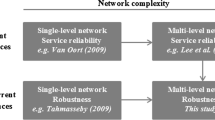Abstract
In this paper, a dynamic and stochastic notion of public transport network vulnerability is developed. While previous studies have considered only the network topology, the granular nature of services requires a more refined model for supply and demand interactions in order to evaluate the impacts of disruptions. We extend the measures of betweenness centrality (often used to identify potentially important links) and link importance to a dynamic-stochastic setting from the perspectives of both operators and passengers. We also formalize the value of real-time information (RTI) provision for reducing disruption impacts. The developed measures are applied in a case study for the high-frequency public transport network of Stockholm, Sweden. The importance ranking of the links varies depending on the RTI provision scheme. The results suggest that betweenness centrality (passenger/vehicle flows) may not be a good indicator of link importance. The results of the case study reveal that while service disruptions have negative effects and RTI may have significant positive influence, counter examples also exist due to secondary spillover effects.








Similar content being viewed by others
References
Angeloudis P, Fisk D (2006) Large subway systems as complex networks. Phys A Stat Mech Appl 3:553–558
Ball MO, Golden BL, Vohra RV (1989) Finding the most vital arcs in a network. Oper Res Lett 8:73–76
Berche B, von Ferber C, Holovatch T, Holovatch Y (2009) Resilience of public transport networks against attacks. Eur Phys J B 71:125–137
Berdica K (2002) An introduction to road vulnerability: what has been done, is done and should be done. Transp Policy 9:117–127
Carson Y, Maria A (1997) Simulation optimization: methods and applications. Proceedings of the 1997 Winter Simulation Conference, 118–126
Cats O (2013) Multi-agent transit operations and assignment model. Procedia Comput Sci 19:809–814, The 2nd International Workshop on Agent-based Mobility, Traffic and Transportation Models, Methodologies and Applications (ABMTRANS)
Cats O, Koutsopoulos HN, Burghout W, Toledo T (2011a) Effect of real-time transit information on dynamic passenger path choice. Transp Res Rec 2217:46–54
Cats O, Larijani AN, Burghout W, Koutsopoulos HN (2011b) Impacts of holding control strategies on transit performance: a bus simulation model analysis. Transp Res Rec 2216:51–58
Colak S, Lus H, Atligan AR (2010) Vulnerability of networks against critical links failure. Available at: http://arxiv.org/abs/1012.5961v2
Criado R, Hernández-Bermejo B, Romance M (2007) Efficiency, vulnerability and cost: an overview with applications to subway networks worldwide. Int J Bifurcation Chaos 17:2289–2301
Crucitti P, Latora V, Porta S (2007) Centrality measures in spatial networks of urban streets. Phys Rev E 73:1–5
Derrible S, Kennedy C (2010) The complexity and robustness of metro networks. Physica A 389:3678–3691
Dowling R, Skabardonis A, Alexiadis V (2004) Traffic analysis toolbox volume III: guidelines for applying traffic microsimulation modeling software. U.S. Department of Transportation, Federal Highway Administration (FHA), Washington DC
Freeman LC, Borgatti SP, White DR (1991) Centrality in valued graphs: a measure of betweenness based on network flow. Soc Networks 13:141–154
Jenelius E, Mattsson L-G (2012) Road network vulnerability analysis of area-covering disruptions: a grid-based approach with case study. Transp Res A 46:746–760
Jenelius E, Mattsson L-G (2014). Road network vulnerability analysis: Conceptualization, implementation and application. Comput Environ Urban Syst, accepted for publication.
Jenelius E, Petersen T, Mattsson L-G (2006) Importance and exposure in road network vulnerability analysis. Transp Res A 40:537–560
Latora V, Marchiori M (2007) A measure of centrality based on network efficiency. New J Phys 9:188
Mahmassani HS, Jayakrishnan R (1991) System performance and user response under real-time information in a congested traffic corridor. Transp Res A 25:293–307
Murray-Tuite PM, Mahmassani HS (2004) Methodology for the determination of vulnerable links in a transportation network. Transp Res Rec 1882:88–96
Nicholson AJ, Du ZP (1994) Improving network reliability: a framework. In: Proceedings of 17th Australian Road Research Board Conference, 3:1–17
Ratliff HD, Sicilia GT, Lubore SH (1975) Finding the n most vital links in flow networks. Manag Sci 21:531–539
Scott DM, Novak DC, Aultman-Hall L, Guo F (2006) Network robustness index: a new method for identifying critical links and evaluating the performance of transportation networks. J Transp Geogr 14:215–227
SL – AB StorStockholms Lokaltrafik (2009) Annual report 2009. Available at: http://sl.se/Global/Pdf/Rapporter/SLfakta_2009_webb.pdf [in Swedish]
Sohn J (2006) Evaluating the significance of highway network links under the flood damage: an accessibility approach. Transp Res A 40:491–506
Taylor MAP, Susilawati (2012) Remoteness and accessibility in the vulnerability analysis of regional road networks. Transp Res A 46:761–771
Toledo T, Cats O, Burghout W, Koutsopoulos HN (2010) Mesoscopic simulation for transit operations. Transp Res C 18:896–908
von Ferber C, Holovatch T, Holovatch Y, Palchykov V (2009) Public transport networks: empirical analysis and modeling. Eur Phys J B 68:261–275
von Ferber C, Berche B, Holovatch T, Holovatch Y (2012) A tale of two cities: vulnerabilities of the London and Paris transit networks. J Transp Secur 5(3):199–216
Acknowledgments
The authors would like to thank Lars-Göran Mattsson, participants at the 5th International Symposium on Transportation Network Reliability (INSTR), 18–19 December 2012, Hong Kong, and two anonymous reviewers for their valuable suggestions and comments on the paper.
Author information
Authors and Affiliations
Corresponding author
Rights and permissions
About this article
Cite this article
Cats, O., Jenelius, E. Dynamic Vulnerability Analysis of Public Transport Networks: Mitigation Effects of Real-Time Information. Netw Spat Econ 14, 435–463 (2014). https://doi.org/10.1007/s11067-014-9237-7
Published:
Issue Date:
DOI: https://doi.org/10.1007/s11067-014-9237-7




